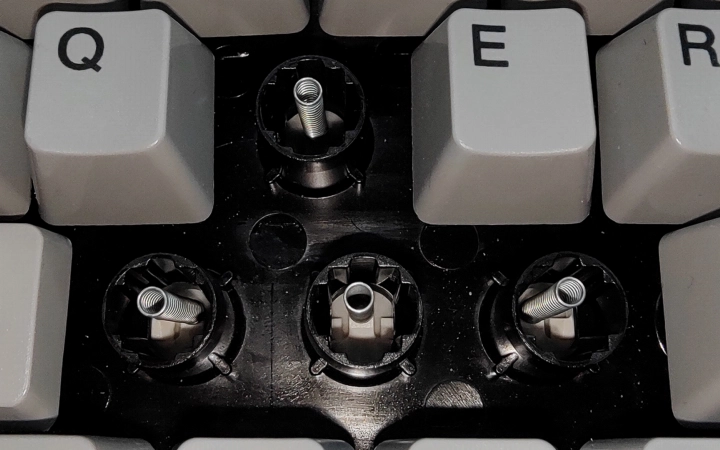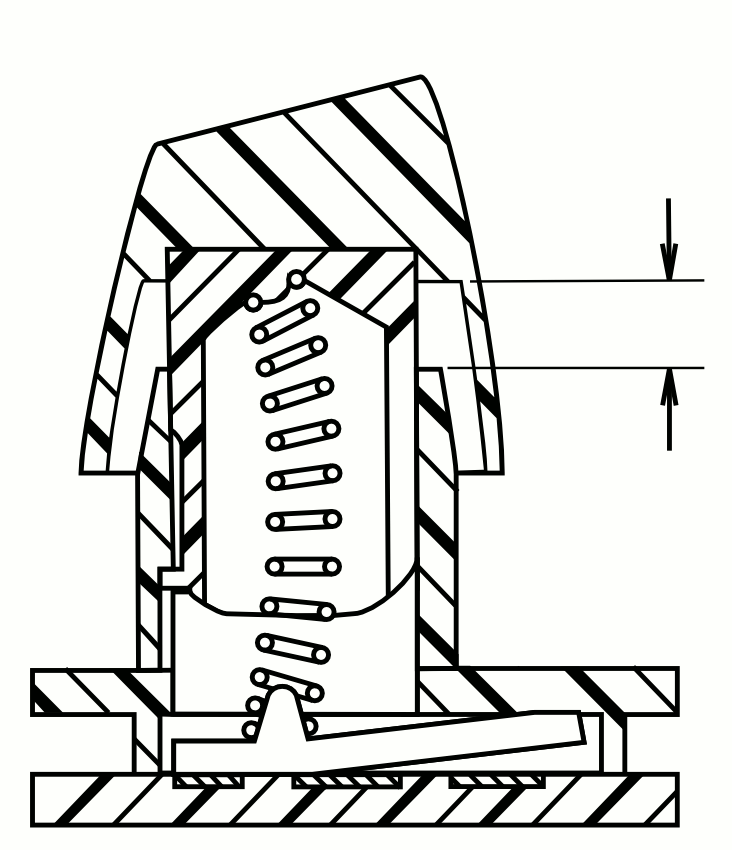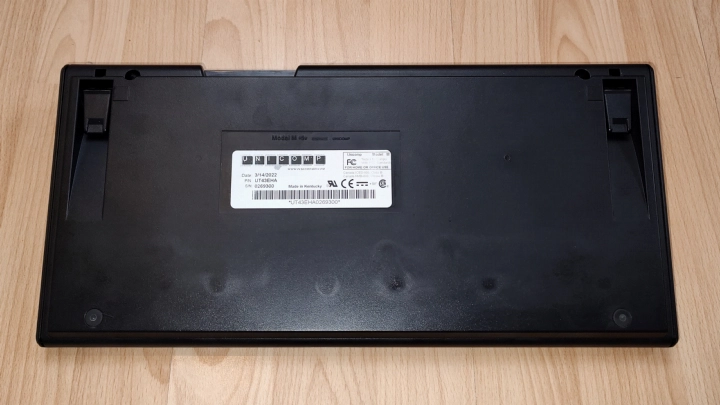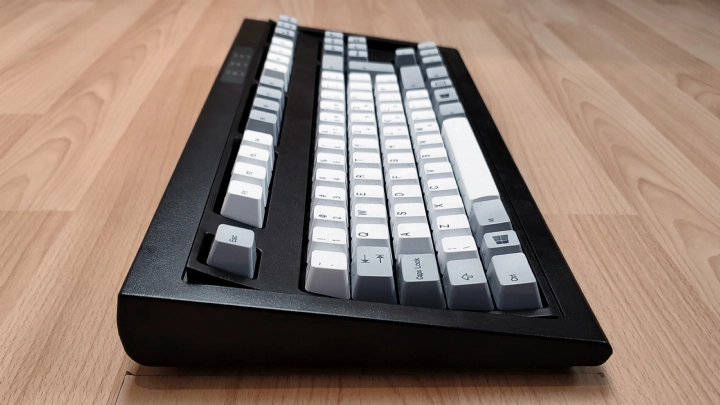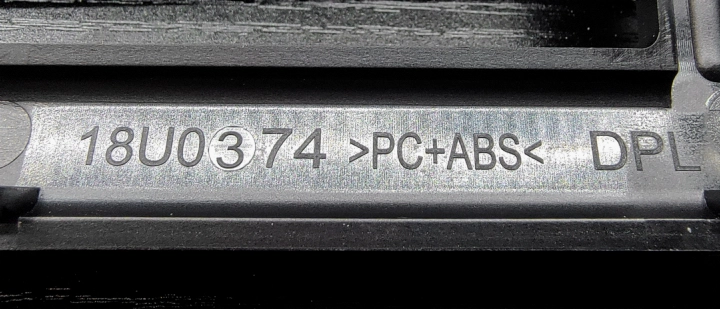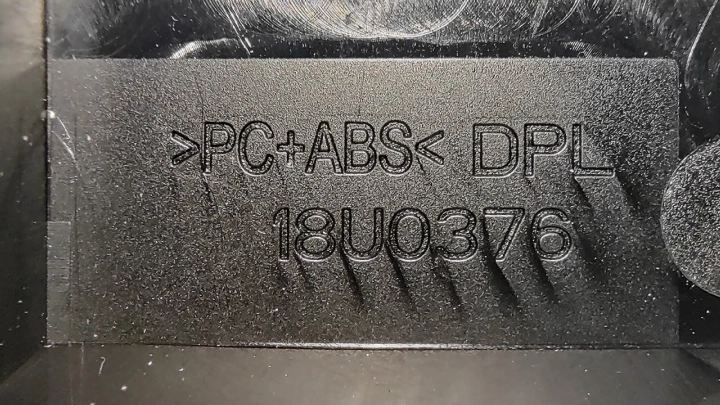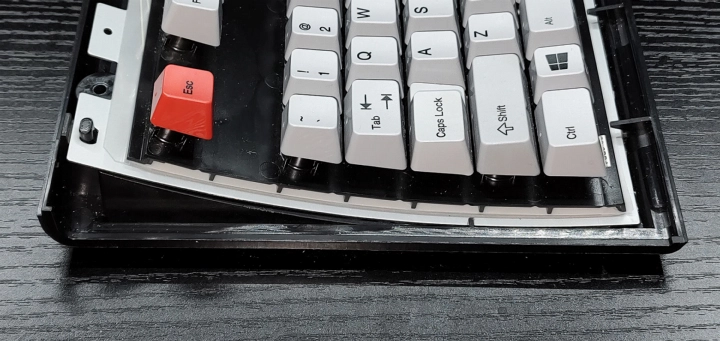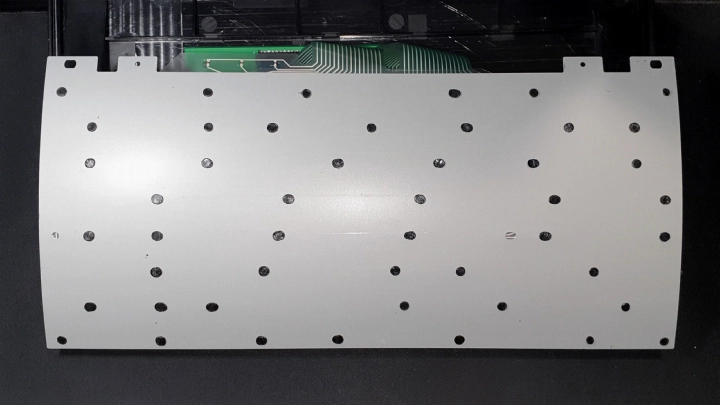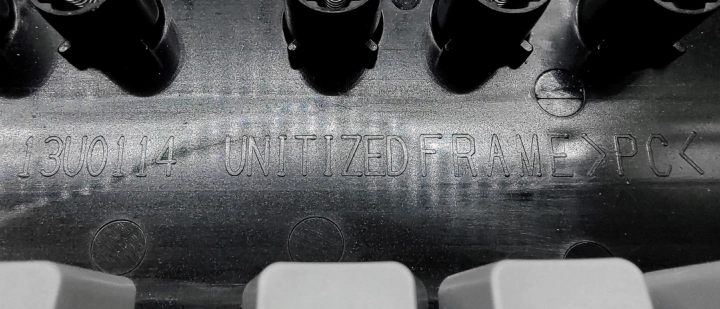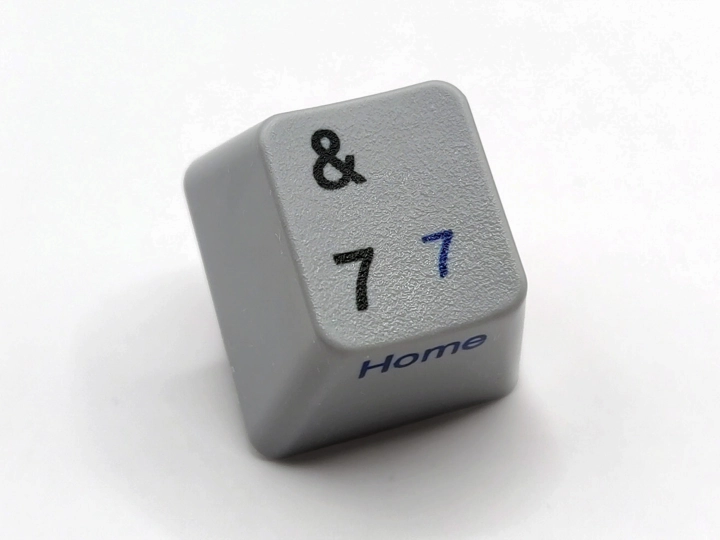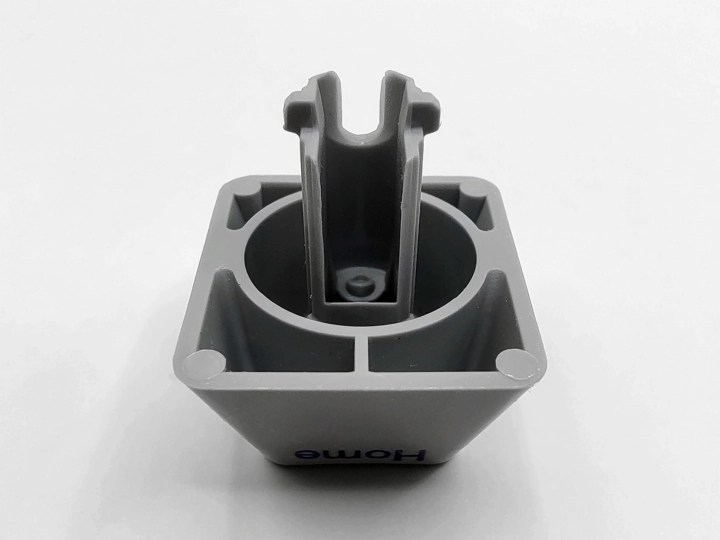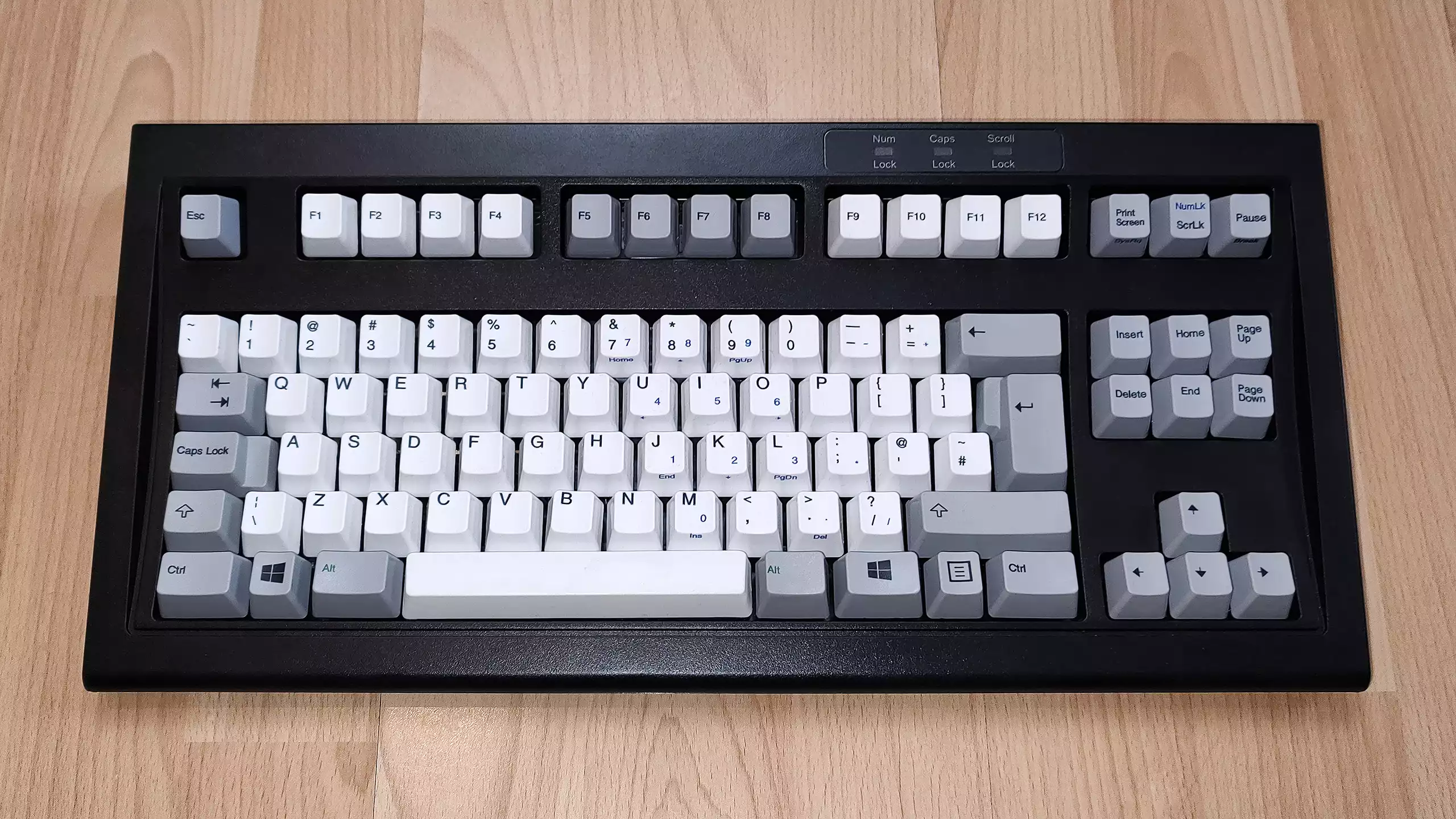- Updated
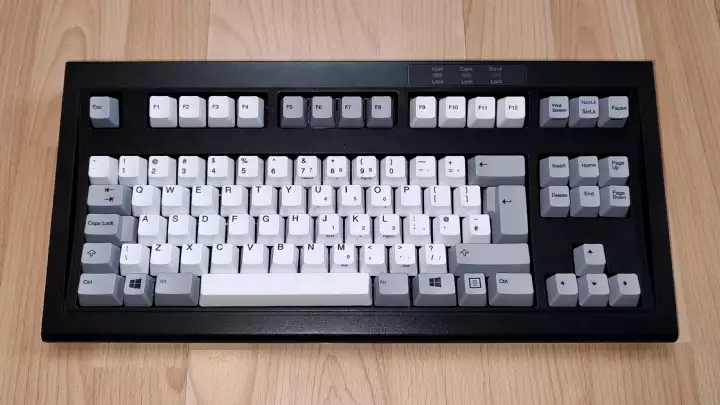
The Unicomp Mini Model M (simply known as "Mini M" by most) is a small form-factor member of the IBM Model M keyboard family introduced in 2021 as a tenkeyless counterpart to the Unicomp New Model M released a year prior and as a long-awaited replacement to the IBM Space Saving Keyboard (SSK). It is produced with Unicomp's updated moulds based on the design first introduced for the aforementioned New Model M and represents the first major revision to the buckling spring Model M design since 1995 when IBM introduced the fourth-generation IBM Enhanced Keyboard with an "overnumpad" controller card. Whilst the buckling springs themselves remain the same classic design as before, Unicomp revamped its membrane assembly design that allows the keyboard to output larger key combinations despite its inherent 2-key rollover limitation. Whilst the keyboard's production has been plagued with at first a firmware issue and later COVID-19-related supply issues, the Mini M is considered to be a hopeful sign of Unicomp modernising its keyboard design by improving existing technology without destroying what a Model M is at its core.
Contents
| Marketing names | Unicomp Tenkeyless (pre-release) Unicomp Mini Model M (official) |
|---|---|
| OEM(s) | Unicomp |
| Designation | MINI-M (pre-release) M |
| Family | Model M |
| First appeared | 20th December 2019 (announced as Unicomp Tenkeyless)[1] 24th February 2021 (on sale as Unicomp Mini Model M)[2] |
| Switches | IBM buckling spring (membrane variant) |
| Keycaps | Dye-sublimated PBT |
| Overall dimensions | 39.5cm x 19cm x 5.94cm (15.5" x 7.5" x 2.34")[3] |
| Cover set material | PC + ABS |
| Cover set colour(s) | Raven black |
| Weight | 1.47kg (~3.24lbs)[3] |
| Layout | 87 (ANSI) or 88 (ISO) key tenkeyless |
| Connectivity | Modular cable: Type-A USB to Type A USB |
| Predecessor | IBM Space Saving Keyboard |
History
Ever since the discontinuation of the IBM Space Saving Keyboard (SSK), Unicomp had continuously faced calls to reproduce or develop a new tenkeyless Model M keyboard. For most of the 2010s, it was understood Unicomp was developing such a keyboard but details on any progress were scarce. In a Form 10-K annual report filed by Unicomp's then-new parent company (Visual Display Corporation), it was mentioned during their fiscal year 2018, Unicomp were in fact "developing a new line" of keyboards[4]. Before 2019, the only visual glimpse of such a new Unicomp keyboard was their 1st April 2014 concept illustration that portrayed a radical departure from a typical Model M design[5].
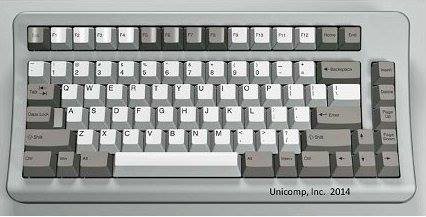
It is unclear if this design was seriously considered as some believe this was an April Fools' joke due to its timing. It was known as the "M83" and its featureset was ambitious for a Model M design as versions with an integrated USB hub, a pointing stick, the reintroduction of a detachable cable, and Fn layer functionality all were slated. The concept illustration was designed by M. Farwig[6]. It's unknown if any prototypes were constructed. In the 5 years following that, Unicomp ultimately designed and produced a more conservative and classic design called the Unicomp Tenkeyless (albeit exclusively in a raven black cover set colour).

The Tenkeyless was announced on 20th December 2019 and was slated for a March 2020 release. A $25 USD gift voucher could be purchased to preorder the keyboard, with a $105 follow-up payment expected on launch[1]. The keyboard retains the classic Model M wedge shape but has reduced top-facing side bezels compared to Enhanced Keyboards and SSKs but is similar to those found on Type 3 and Type 4 122-key Converged Keyboards. The keyboard also retains the detachable cable feature previously suggested for the "M58" in the form of a pressure-locking Type-A USB port to facilitate a Type-A to Type-A cable. At this point, the keyboard's overlay numeric keypad and Num Lock key were not shown in the pre-release photos. The bottom low layout is also unaltered compared to Unicomp's existing "104" style keyboards introduced in 2013[7] and its lock-light LED overlay sticker had Unicomp's unique symbols.
Due to the effects of the subsequent COVID-19 pandemic, the launch was pushed back several times. During this time, the keyboard received its final name - the Unicomp Mini Model M or simply "Mini M". During this time, its full-size counterpart, the Unicomp New Model M, was launched. Several prototypes of P/N UB40E7A were sent out to keyboard and vintage hardware content creators for critical review a month or two before launch; including to Admiral Shark's Keyboards and chyrosran22[8]. These keyboards had a unique 20210xx serial nomenclature.
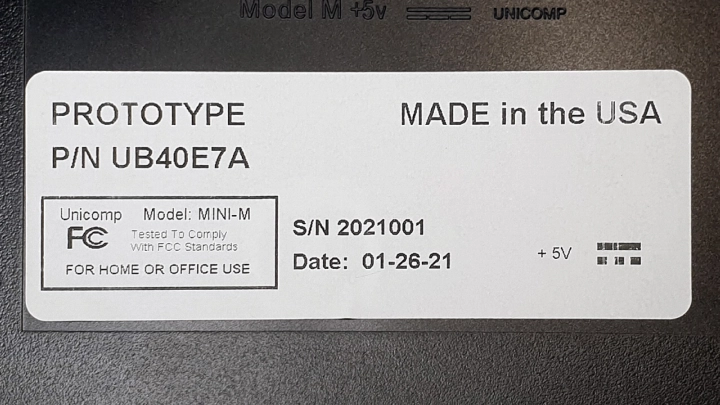
The keyboard finally went on sale on 24th February 2021 and started shipping on 20th March 2021 to the United States only[2]. Compared to the Tenkeyless prelease, the final release sported sublegends across their alphanumeric keys for an SSK-like overlayed numeric keypad. The Alt keys and the "SysRq" text received green legends as a call-back to the green-text Alt keys of early PC-compatible Enhanced Keyboards and SSKs. The lock-light LED overlay sticker now sports only text instead of only symbols.
It was found that there were two issues with the controller card and its firmware. Firstly, its Cypress microcontroller was unusually hot to touch and the Q key would sometimes stop operating. Unicomp formally acknowledged the issue on their Facebook page on 30th July 2021 and introduced a new firmware update (version 7.56) that was believed to reduce the likelihood of "dead-Q"[9]. A final fix was eventually released on 11th November 2021[10], which was firmware version 7.57 and seems to have completely fixed both the hot IC and "dead-Q" issues[11][12][13].
Since the fallout of the COVID-19 pandemic, production of the Mini M was affected on several occasions. On 15th April 2022, Unicomp announced they were suspending new orders for Mini Ms (and many other products) due to the grounding of a container ship carrying vital parts in Chesapeake Bay, Maryland and Virginia. But despite that, Unicomp completed CE marking for the Mini M by 15th April 2022[14]. The parts were recovered by 13th May 2022[15] and worldwide shipping began thereafter.
By 8th July 2022, the Mini M was pulled from sale as the microcontroller used for its controller card had not been available for two years prior and Unicomp ran out of supply for sustainable production[16]. The Mini M eventually relaunched on 16th April 2023[17], bearing a new Raspberry Pi Pico based controller card (codename Mike Smith/Justify). This new controller card opened the door for reprogrammability since it can be reflashed with QMK or Vial-QMK firmware.
| Date | Notes | Original price | 2023 price |
|---|---|---|---|
| 2019-12-20[1] | Total pre-order price (gift certificate + follow-up payment) | $105 USD[18] | ~$124 USD |
| 2021-02-25 | Original price | $121 USD[3] | ~$135 USD |
| 2023-04-17 | Relaunch price | $149 USD[19] | Current price unchanged |
Unicomp retains the classic IBM buckling spring over membrane clicky key-switches from past Model Ms for the Mini M. Such a switch is comprised of a coil spring, a rocker (also known as a flipper or hammer, the white piece of plastic visible underneath the springs in the photo above) and the membrane circuitry underneath - pressing down on a buckling spring key causes the coil spring to compress and eventually buckle, which then rocks the flipper attached to the bottom of the spring thus actuating the membranes[21]. The mechanism rocks the membranes before its fully buckled (bottomed out), allowing for part-way actuation. Key travel is 3.8mm[22].
Key-matrix
Despite some misquotes that the Unicomp Mini M is a 6, 8 or even 10-key rollover keyboard, it's still a membrane keyboard without diodes and thus technically limited to 2KRO. However, the membrane assembly used in the Mini M is very different to past Model M variants and was designed to limit possible issues with blocking thanks to an 'oversized' key matrix. Whilst classic Enhanced Keyboards and SSKs used a 16x8 (128 possible positions) matrix, the Unicomp Mini M instead sports a 16x12 (192 possible positions) matrix. In theory, this means the 87/88 keys the Unicomp Mini M has can be assigned to the matrix much more spaciously than in a 16x8 matrix, thus keys are less likely to cause issues (blocking, ghosting, etc.) with each other. The fundamental 2KRO limitation will mean there will still be hard-2-key limited combinations within the matrix, but the number of instances of these can be suppressed compared to previous designs depending on how the matrix was designed.
/u/whiskerbiskit and Purdea Andrei (/u/_pandrew) on /r/ModelM first mapped out the matrix in April 2021[23], and from that, it was found Unicomp optimised the matrix so that all the alphabetic keys on the first, second (home) and third row cannot conflict with their neighbours on the same row. This was achieved by giving each key on the first and second rows its own matrix column and each key on the third row its own matrix row. This also resulted in the entire left half ("Q" to "T", "A" to "G" and "Z" to "B") or the entire right half ("Y" to "P", "H" to "L" and "B" to "M") of the alphabetic keys to be pressable together, the latter fact crucially allowing all "WASD" keys to be pressable together (a notable limitation with Enhanced Keyboards and SSKs). 2KRO still presents some limitations though, both synthetic (unlikely to notice) and realistic. In regards to synthetic limitations, pressing an entire alphabetic row or half of the three alphabetic rows as described before will severely limit the number of other keys you can press elsewhere on the keyboard. But that should not be an issue during standard usage. Some more realistic limitations can be found amongst the symbol, arrow and navigation keys where the matrix isn't as optimised.

Compared to previous Unicomp keyboards, the USB interface now supports reporting up to 10-key combinations[3] (which is likely the fact misquoted as "10KRO"). To summarise, the combination of the new matrix and new USB interface allows the Mini M to support many 6 and 8-key combinations from the alphanumeric keys despite the technology inherently still being 2KRO, whereas Enhanced Keyboards and SSKs are generally limited to 3 and 4-key combinations.
The Unicomp Mini M is designed to heavily resemble the SSK and thus retains the same basic overall design including the distinctive wedge-shaped cover. The side profile matches that of the SSK, which is an established size also used by the IBM PS/2 50-key Function Keyboard, IBM Screen Reader Keypad and Unicomp New Model M. This cover set shape facilitates a curved internal assembly that partially swoops up above the F-keys, granting space commonly used to hold items such as pens or pencils. Whilst the SSK was known for shrinking the aforementioned space above the F-keys compared to the Enhanced Keyboard, the Mini M takes this a step further by shrinking the space between the sides of the keyboard and the keys.
The cover set is made from polycarbonate (PC) and acrylonitrile butadiene styrene (ABS) copolymer. The top cover piece part number is 18U0374 and the bottom piece part number is 18U0376.
Unicomp retained the same basic curved inner assembly design for the Mini M as most previous buckling spring Model M keyboards. The assembly is comprised of four layers; the keyboard frame and actuators, the membrane blanket, the membrane assembly, and the base plate.
- The keyboard frame (aka, "barrel plate") sits top facing and is used to guide the individual switch components (the buckling spring actuators) to their correct position above the membrane assembly's contact points. The frame design has a degree of redundancy in the number of barrels available, allowing for a 'one size fits all' design for ANSI and ISO layout keyboards. The frame has a part number of 13U0114 and is made of polycarbonate (PC) and is simply a cut-down version of the frame used for the New Model M.
- The membrane blanket is a latex sheet used to dampen the stress the actuators exert on the membrane assembly. A Unicomp employee posting on /r/ModelM Discord has stated that a Model M without the blanket is unlikely to reach the rated 25 million key-presses lifetime[24].
- The membrane assembly is a part of the key-switch system used as the circuitry to be actuated and facilitates a 16x12 matrix.
- The base plate (aka, "back plate") provides rigidity and the curvature for all the other layers to follow.
The assembly is held together by many plastic rivets designed to provide the tension needed for the buckling springs to operate properly. Unfortunately, these rivets are the single largest flaw in the Model M design as they can weaken and break with age. Such an issue can be permanently solved with a bolt or screw mod.
The Unicomp Mini M's keycaps are based on IBM's famed PBT dye-sublimated keycaps. Whilst the font and available colours now differ from the classic IBM keycaps, the core properties remain the same. Versus the most common keycap material, ABS[25], PBT is more durable, does not degrade/yellow with age, UV or heat exposure, and will keep its texture for longer without shining[26]. Dye-sublimation is also a very durable text printing method that sinks dye material into the keycap's plastic itself, meaning there is nothing to quickly wear off as would be the case with pad-printing or silk screening. This means these keycaps can remain in good condition for a long time. Unicomp presently doesn't supply the classic two-piece keycap design (where the keycap existed as a separate stem and keytop) as its standard offering, thus Mini M keycaps are almost always the single-piece type.
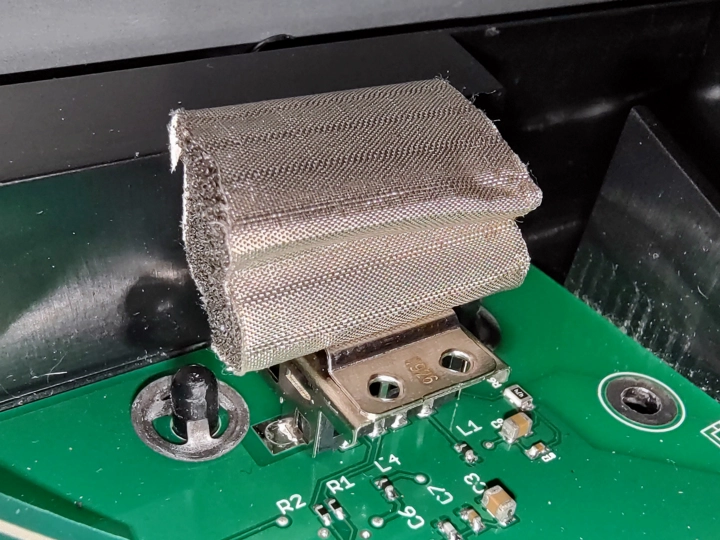
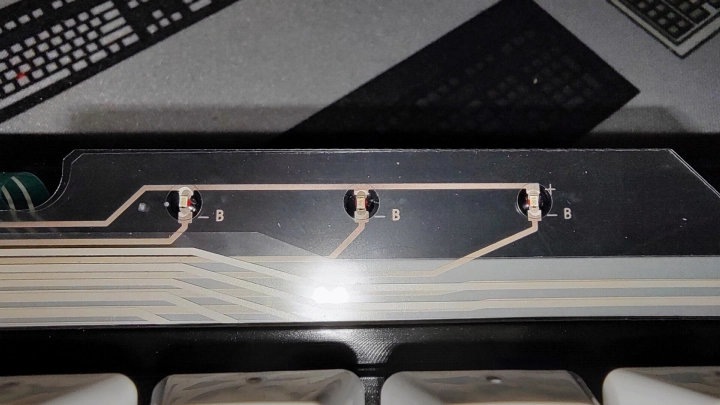
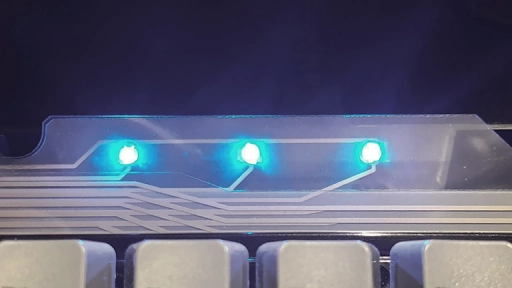
To facilitate the updated membrane design, Unicomp created an entirely new controller card design from scratch to suit the keyboard. This new controller card resembles earlier Model M controllers such as those found in the SSK rather than the "overnumpad" style pressure-fit controller found on all other Unicomp keyboards presently in production. The new controller card is larger and returns to using Triomate sockets for the membrane flex cables. The Mini M implements a modular cable system using an Amphenol-made lockable USB (LUSB) socket (part number LUSBA11100[27], operation described in Connectivity section). Lock-light LEDs are embedded in the membrane assembly itself, something unseen in any Model M keyboard before.
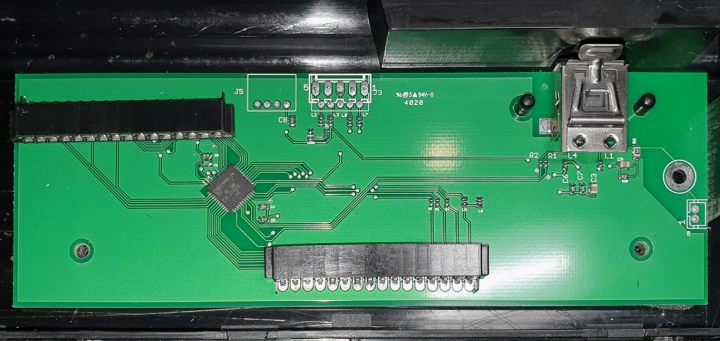
The original controller card for the Mini M used a Cypress CY8C24493-24 programmable embedded system-on-chip. This microcontroller is clocked at 24MHz, has 2KB SRAM, 32KB flash memory, and 36 I/O pins[28]. "AP1" seems to be the controller card's name as per the USB descriptor. This microcontroller has since been discontinued[29], prompting Unicomp to redesign the controller card.
In light of the CY8C24493-24's discontinuation, Unicomp developed a new controller card based around the Raspberry Pi Pico microcontroller board. This new controller was codenamed "Justify/Mike Smith"[30]. "Justify" is the mainboard of the controller, named after a Kentucky racehorse and following the convention of Unicomp's previous controller card names such as the "Ruffian" USB pressure-based controller for Unicomp 101-105 and 122 key keyboards. "Mike Smith" is the daughterboard for the left Triomate socket and four LVC125A quadruple bus buffer gates and is named after a jockey who once rode Justify. On 16th April 2023, Unicomp relaunched the Mini M with this new controller card[17].
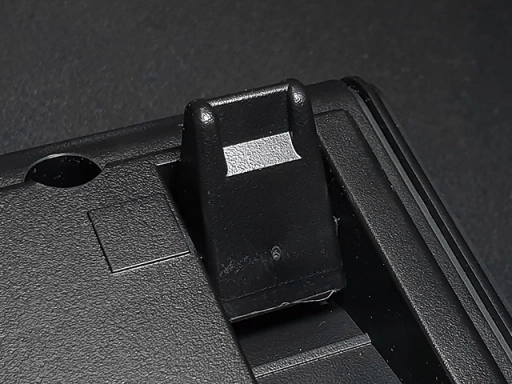
The Unicomp Mini M's flip-out feet style is the same as the SSK's and the Unicomp New Model M's. It resembles a shortened [https://sharktastica.co.uk/image?id=fLghP7rx) and appears more robust than the Enhanced Keyboard/Unicomp Classic style feet.
Layout
The Unicomp Mini M's physical and functional layouts are an evolution of the original SSK's layout (with in turn is a reduced version of the IBM Enhanced layout). Unicomp reimplemented a layer-based numeric keypad that the original SSK is noted for, which overlays some of the alphanumeric keys. The numeric keypad can be activated by turning on the num lock, and then the navigation commands within it can be used by shift-pressing the relevant keys. To compensate for the loss of a dedicated Num Lock key (which would normally be found within the numeric keypad on Enhanced layout keyboards), the Num Lock key is instead doubled up with the Scroll Lock key and is activated by shift-pressing the key. Thanks to the inclusion of lock-light LEDs compared to the original SSK, the consideration for possible rogue num lock causing frustration is no longer an issue. Key legends relating to the overlay numeric keypad are coloured in blue.
Compared to the SSK, three new keys are now present on the Mini M for GUI-centric operations. Namely a 1-unit super (usually, Windows) key in between the left Ctrl and Alt keys, a 1.25-unit super key and a 1-unit context menu key in between the right Alt and Ctrl keys. As a compromise between reusing their existing keyboard frame design used since 2013 and arranging the keys in the now industry standard arrangement (ie, Ctrl, Super, Alt, Space, Alt, Super, Context Menu, Ctrl), the Alt key is now positioned on the 1.25-unit key directly right of the spacebar instead of the on the 1.5-unit key right of the 1.25-unit key as Unicomp positions it on their other keyboards.
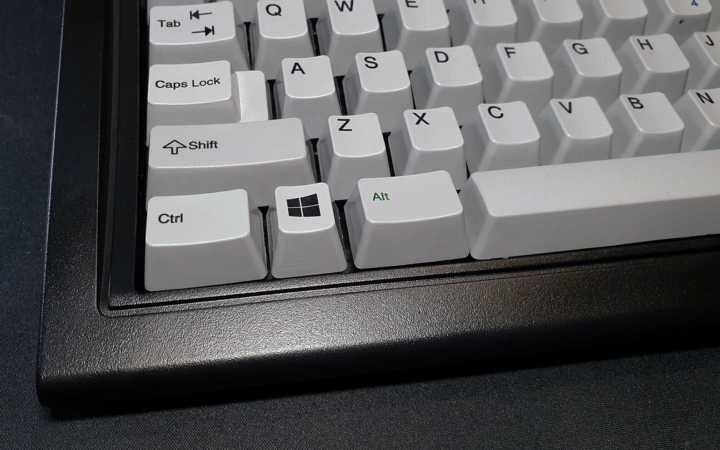
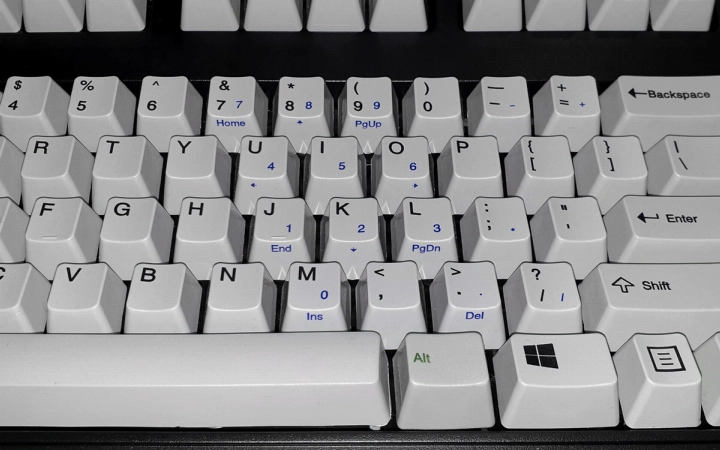
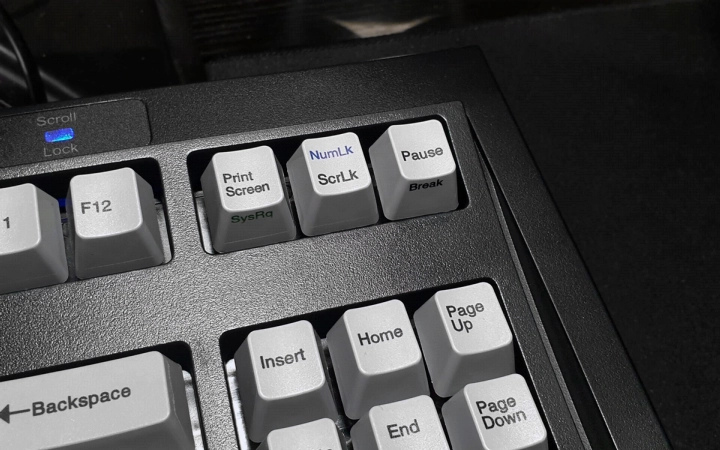
As with the SSK, the Mini M physical layouts are generally ANSI or ISO styles depending on region and/or language. ANSI (named after the American National Standards Institute) is typical for US English, Korean, Thai, non-bilingual Canadian and sometimes Danish keyboards, whereas ISO (named after the International Organization for Standardization) is typical for European, Middle Eastern and African (EMEA), South American and bilingual Canadian keyboards. For Japanese keyboards, the typical JIS (named after Japanese Industrial Standards) bottom row is not implemented due to a lack of moulds for JIS' smaller spacebar, thus Unicomp uses a variation of the "short spacebar" bottom row to support Japanese-centric keys at the expense of GUI keys. Due to the above, the following layout configurations are known:
- 87-key ANSI
- 88-key ISO
- 89-key Japanese
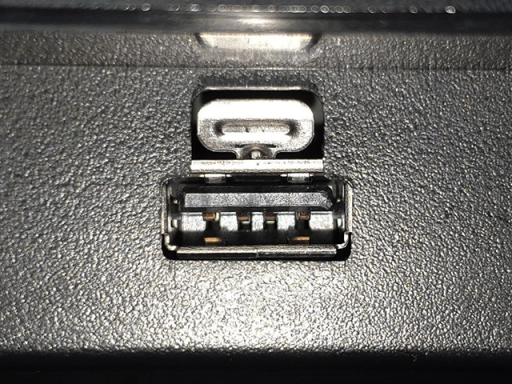
The Mini M is only available as a USB keyboard. Unlike Unicomp's previous USB keyboard designs, the cable is detachable as a homage to the modular (albeit, SDL-based) connectivity of the original SSK. A Type A to Type A USB cable is socketed via a lockable USB (LUSB) connector, which has a pressure-release tab that will grip an inserted Type A USB plug and can be released when the tab is pressed. The LUSB socket's tab is recessed, so a tool like a screwdriver or possibly a thin pen will be needed to reliably push the tab.
Internal
External (reference)
External (reviews)
- Unicomp - 2019-12-20 Facebook Post [accessed 2023-02-20].
- Unicomp - 2021-02-24 Facebook Post [accessed 2023-02-20].
- Unicomp - Mini M [accessed 2023-02-20]. License/note: retrieved via Wayback Machine (2021-02-25 capture).
- U.S. Securities and Exchange Commission - Visual Display Corporation's Form 10-K for February 28, 2018 [accessed 2023-11-05].
- Unicomp - 2014-04-01 Facebook Post [accessed 2023-02-20].
- Unicomp - April 1, 2014 Press Release [accessed 2023-02-20]. License/note: photo used under fair dealing.
- Unicomp - Unicomp Product News - Revised 104-key Layout [accessed 2022-02-20].
- Chyrosran22 - Unicomp Mini-M (IBM SSK repro) review (buckling springs) [accessed 2023-03-04].
- Unicomp - 2021-07-30 Facebook Post [accessed 2023-03-02].
- Unicomp - 2021-11-11 Facebook Post [accessed 2023-03-02].
- /u/plazman30 - My Mini-M back from Unicomp for the Q key issue permanent fix. Serial Number 99. Unicomp Customer Service it outstanding! [accessed 2023-03-02].
- /u/Ok-Whole9542 - Comment on Unicomp Mini M - Does it still have firmware issues? [accessed 2023-03-02].
- /u/MS310 - Comment on Mini M "Dead Q" Update from Unicomp's Facebook Page [accessed 2023-03-02].
- Unicomp - 2022-04-15 Facebook Post [accessed 2023-03-02].
- Unicomp - 2022-05-13 Facebook Post [accessed 2023-11-05].
- Unicomp - Unicomp, Inc. [accessed 2023-04-17]. License/note: retrieved via Wayback Machine (2022-07-08 capture).
- Unicomp - 2023-04-16 Facebook Post [accessed 2023-04-17].
- Unicomp - Gift Certificate [accessed 2023-04-17]. License/note: retrieved via Wayback Machine (2020-01-22 capture).
- Unicomp - Mini M [accessed 2023-04-17]. License/note: retrieved via Wayback Machine (2023-04-17 capture).
- Shaddim - File:Bucklingspring-animation-300ms.gif [accessed 2021-09-09]. License/note: CC-BY-2.0.
- IBM - Rocking switch actuator for a low force membrane contact switch [accessed 2021-06-17].
- Unicomp - The Customizer Keyboard [accessed 2022-10-04]. License/note: retrieved via Wayback Machine (2000-06-14 capture).
- /u/whiskerbiskit - Unicomp Mini M membrane matrix information [accessed 2023-02-24].
- troyfletcher#5223 - Discord Message #252446027745853442 on IBM keyboards | /r/ModelM & F [accessed 2023-02-21].
- WASD Keyboards - Mechanical Keyboard Guide [accessed 2022-07-01].
- Switch And Click - ABS vs PBT Keycaps: What’s the Difference? [accessed 2021-09-09].
- Amphenol - Harsh Connector - LUSBA11100 [accessed 2023-02-21].
- Infineon Technologies AG - CY8C24493-24LTXI [accessed 2023-02-21].
- Radionics Ltd. - Cypress Semiconductor CY8C24493-24LTXI, CMOS System-On-Chip for USB, 48-Pin QFN [accessed 2023-02-21].
- troyfletcher#5223 - Discord Message #1067085568602816572 on IBM keyboards | /r/ModelM & F [accessed 2023-02-22].
| Published | Comment |
|---|---|
| 22nd May 2025 | Updated summary table styling |
| 6th May 2025 | Updated URL to layout diagrams |
| 11th August 2024 | Improved first half of the "History" section |
| 18th May 2024 | Replaced various used enthusiast terminology with official terminology |
| 14th November 2023 | Improved History and Layout sections based on new research/understanding from writing the New Model M wiki page |
